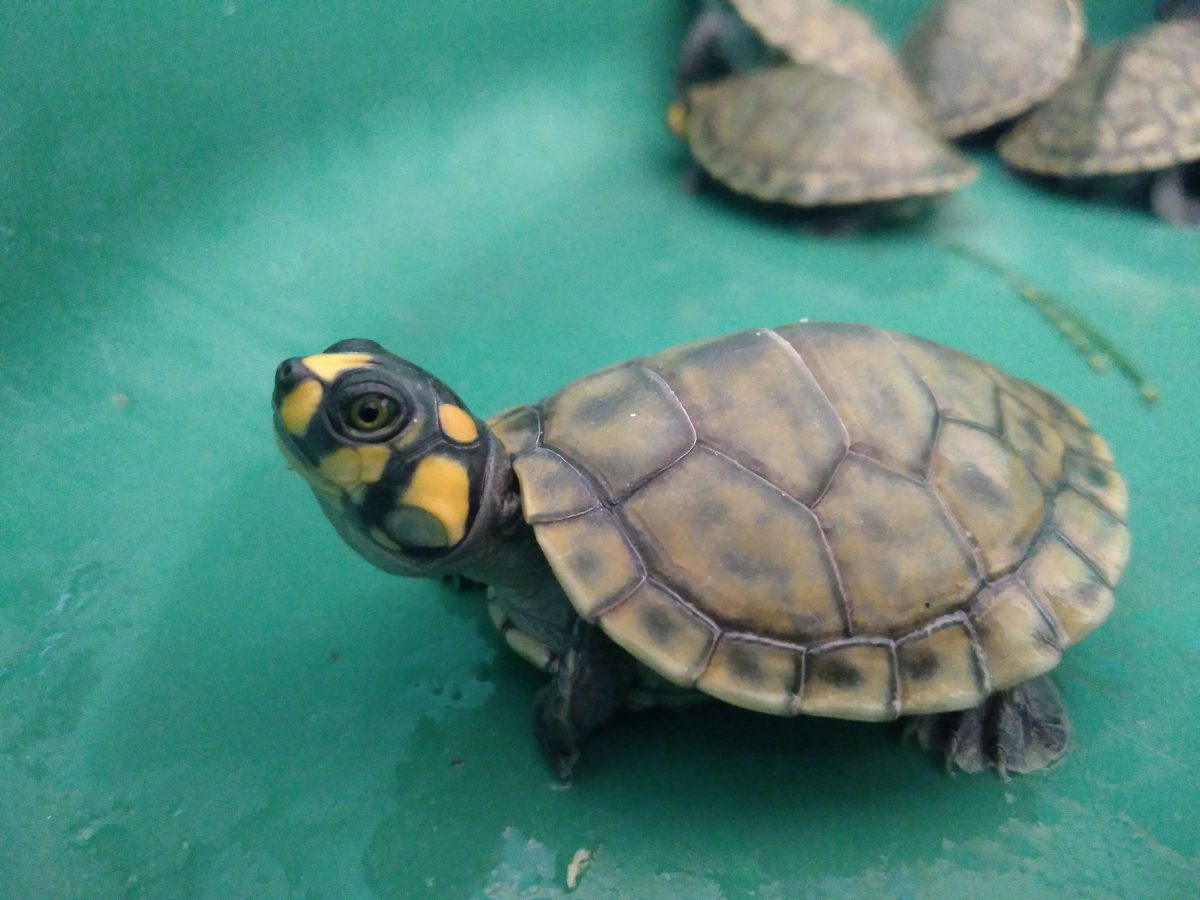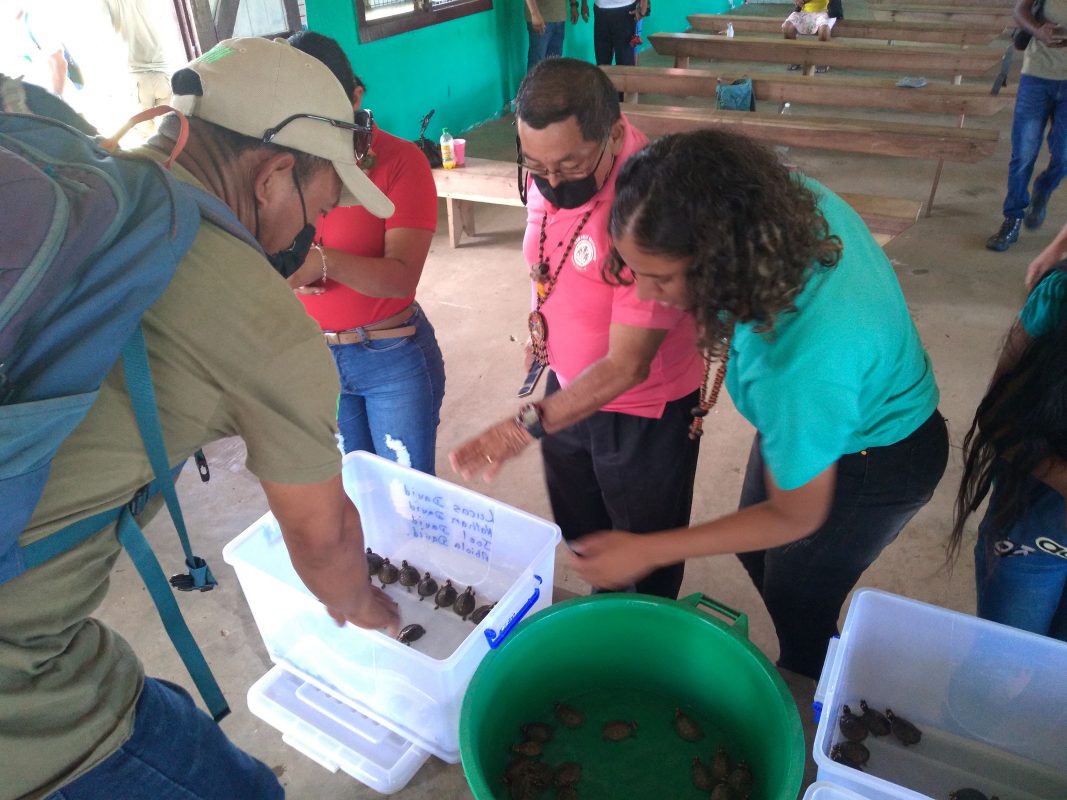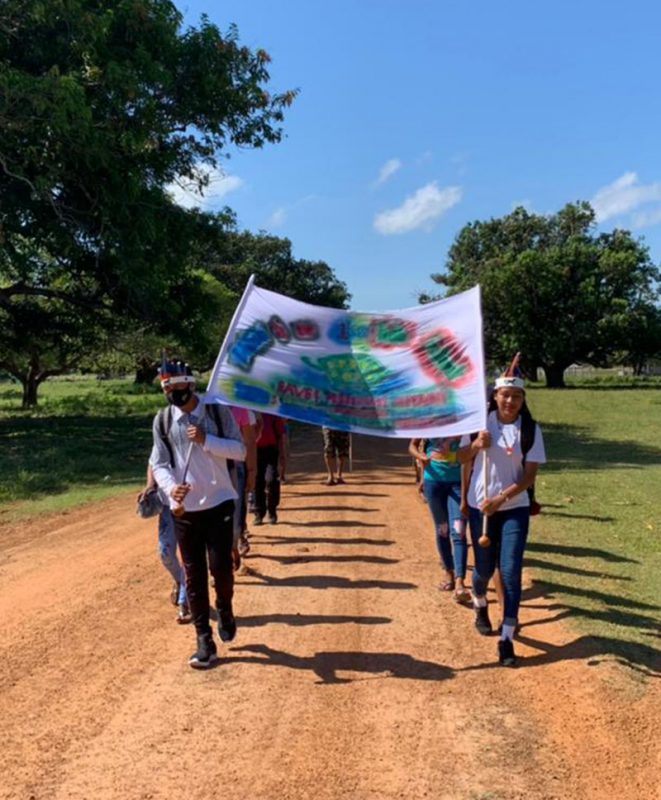After years of feasting on turtles and their eggs as delicacies, the residents of Sand Creek, South Central Rupununi have taken up new traditions. On September 11, through the South Rupununi Conservation Society (SRCS), residents hosted their first turtle festival and released more than 200 yellow-spotted river turtles into the wild after caring for them.
April is said to be the time turtles hatch along the beaches annually. However, due to an unseasonal early rainy season across Guyana, the Rupununi River began to rapidly rise and as a result, the beaches where the turtles nest were inundated. By then, the turtles had already nested along eight beaches. The rangers, who are also villagers from Sand Creek, acted on instinct to save the turtles and worked tirelessly day and night to rescue all the eggs from the nests. Overall, the rangers rescued more than 400 eggs, which they took back with them to the village and cared for.
Back in the day, every year at Christmas time, villagers would capture hundreds of turtles to cook in a variety of ways then share among themselves. In the early 1990s, the turtles were abundant but by their last known feast in the early 2000s, the villagers had only caught 93. Villagers also used to frequent the beaches along the Rupununi River during the hatching season and collect eggs to eat. The residents, particularly the village elders, noticed a serious decline in the turtle population owing to the overharvesting.
In response, the SRCS offered to collaborate with the village to start a turtle conservation project. The project saw eight Sand Creek residents training to become turtle rangers in January this year. The rangers were assigned to eight beaches following the completion of training. As part of monitoring the beaches, the rangers, between January to April, were to prevent people from disturbing the eggs at the beaches.
Then when the beaches began flooding, the rangers, having protected the eggs for months, decided that the only way to keep them safe was to gather them and take them to higher ground and thus took them home. Had they decided not to do this, all of the eggs would likely have been destroyed.
Of the more than 400 eggs collected from the beach, 40 failed to hatch.
The festival saw an attendance of approximately 160 people who witnessed a march past, enjoyed a ceremony of songs, dances and cultural displays, and were involved in activities and games, quizzes and finally the event where more than 200 turtles were released.
The remaining 200 turtles are being cared for by the rangers for research and also to have turtles to release again at next year’s turtle festival.
The games were all designed to teach residents the importance of not overharvesting turtles, which will help to maintain wildlife diversity while still providing a sustainable food source.
Education emphasised
Regional Chairman of Region Nine (Upper Takutu-Upper Essequibo) Brian Allicock, who was in attendance, shared how proud he was to see the villagers graduating from consuming the reptiles to releasing them.
The festival was a milestone for the entire South Rupununi, as it had never been done there. However, Yupukari Village in northern Rupununi has been hosting a turtle festival for the last ten years. “It is equally important to do this in the south as the turtles can be found all throughout the Rupununi River and if only one side protects them, they will be overharvested,” SRCS coordinator Neal Millar said in a release.
Millar said that he has a lot of support from the toshao of the village as well as other residents. The festival, he added, does not prevent villagers from eating the turtles but instead admonishes them to not catch them in abundance. The reptiles, Millar pointed out, are not considered as regular meals as they are not eaten on a daily basis. As mentioned, they are seen as a delicacy that is reserved specially for Christmas time.
“If you want to stop people from harvesting the turtles, you can do all the monitoring you want but if they want, they’ll find a way to get around you. But, the real way for conservation to work and to make a change is to really emphasise the education part so you have to educate people through events like these, through the environmental classes that we’re doing, [and] village nature fairs because that’s the only way you’ll get people to understand the damage … [overharvesting of the turtles] is having. Involving children is one of the best ways because if at the end of the day you go home and your father or your mother says ‘Okay, we’re having turtle for dinner’, the children know about [the impact] of the overharvesting of turtles and will [ask] ‘Mommy or daddy, did you collect this in a [sustainable] way? How many did you get? Why are we eating this all the time?’ And that’s the way you can get to the parents and make a change,” said Millar in an interview.
Endangered
Millar noted that owing to the significant decline in their population, the yellow-spotted river turtle should now be considered an endangered species, which is the reason for the need for people to understand the importance of not consuming them too often or consuming them in abundance. He added that while they cannot stop people from eating the turtles, it was advocated at the festival that people voluntarily make the decision to stop eating them at least for the next five to 10 years, by which time they should no longer be considered endangered and can be harvested at a sustainable level.
According to Millar, the younger generation seems to be more conservation-minded and are enthused about such projects. Since the festival, representatives from other villages in South Rupununi have expressed their desire to see similar festivals held in their areas also.
SCRS will continue to collaborate with Sand Creek in protecting the beaches during the turtle nesting season next year. Millar said once COVID restrictions have been lifted, it is the conservation society’s hope to invite residents from other communities in South Rupununi as part of the plan to reverse the decline of the turtle population.
The SRCS, he said, is working with international scientists to come up with better methods of turtle conservation. Next year, the NGO hopes to extend the project to ten beaches, and have camera traps set up to see who and what are disturbing or harvesting the eggs. Millar also spoke of putting mesh over the eggs along the beaches to prevent harvesting.
There are few persons, he noted, that keep the turtles as pets but the NGO has advocated that the turtles be released back into the wild as they are not domestic animals.
Millar pointed out that in the future, SCRS hopes to move from a voluntary ban to a mandatory ban of harvesting the turtles until a time when the turtle population has been replenished, at which time the ban can be lifted.
The SCRS is one of the leading grassroots conservation NGOs in Guyana, focused on preserving the environment and wildlife of Region Nine. The recent turtle festival project was made possible through the support of the Sustainable Wildlife Management – Programme Guyana, the Turtle Conservation Fund, ReWild and the Protected Areas Commission.








